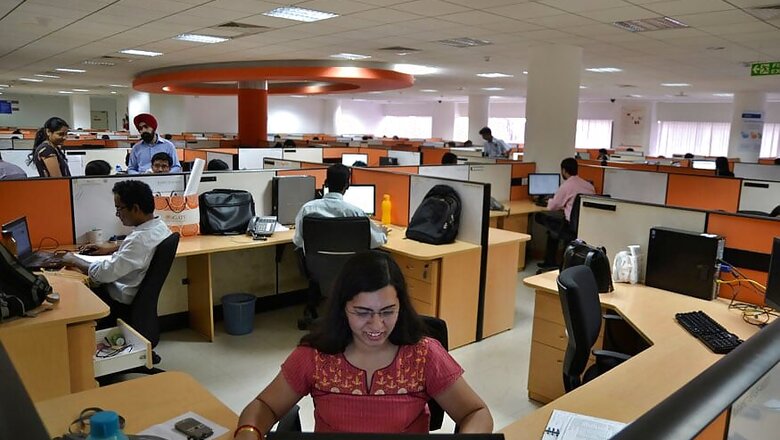
views
United Nations: India is projected to dominate the growth in the working-age population in Asia Pacific by 2050, becoming home to over a billion people eligible to enter the job market, a UN report has said.
The United Nations Development Programme (UNDP) underlined in its latest Regional Human Development Report that Asia-Pacific countries now have more working-aged people and fewer dependents than at any point in history, providing a springboard for growth.
Region-wide, 68 per cent of people are of working age and only 32 per cent are dependents.
Asia-Pacific's population size has tripled in the last 65 years, and is expected to reach 4.84 billion in 2050.
The working-age population in the region, comprising 58 per cent of the global total, continues to grow, the report said.
China and India comprised 62 per cent of the region's share in 2015, with a billion and 860 million workers, respectively.
"When countries have a greater share of people who can work, save and pay taxes, they have the potential to transform their economies and power investments in healthcare, education and other building blocks of future prosperity," said UNDP's chief economist Thangavel Palanivel, who is the lead author of the report.
The report said that China's share of working-age people is now falling while India's continues to rise, expected to touch a maximum of about 1.1 billion in 2050.
The region as a whole will reach its maximum number of working-age people, at 3.1 billion, in 2045.
"South Asia will have more working-age people than any other sub-region, with the largest surge by 2055 to a projected 1.6 billion, dominated by India," the report said.
In India, more than 280 million more people will be eligible to enter the job market by 2050, a third more than the current number.
Further, the report said that most countries in South Asia will have their largest number of working-age people between 2045 and 2050.
"India alone will see the maximum number in 2050, when the population aged 15-64 is expected to be larger than 1 billion," it said.
However the report said that even as the working-age population increases, not all will be absorbed in the job market.
In India, the size of the working-age population increased by 300 million between 1991 and 2013, while the number of employed people increased by only 140 million -- the economy absorbed less than half the new entrants into the labour market.
In China, the number of jobs grew by 144 million between 1991 and 2013 but the working-age population increased by 241 million.
"A wider gap in India than China suggests a more limited capacity to generate employment -- a serious challenge given the continued expansion of the workforce in India over the next 35 years," it said.
In Afghanistan, Bangladesh, India, Nepal and Pakistan, more than 80 per cent of working people earn less than $4 daily, it added.
The share of people working but earning below the international poverty line is still large in Asia-Pacific, and their numbers are likely to escalate with more entrants into the labour force if current employment shortfalls continue.
China and India, now home to 2.6 billion people, will drive demographic changes in the region and influence their consequences.
India's population will likely surpass China's by 2022, possibly earlier, the report said.
It added that the proportion of older people will also increase substantially in India and China, rising from about 9 per cent and 15 per cent, respectively to 19 per cent and 37 per cent in 2050.
In 2015, seven Asian countries, namely Bangladesh, China, India, Indonesia, Japan, Pakistan and the Philippines, had 420 million people aged 60 and older, which accounts for 47 per cent of people aged 60 and above in the world.
By 2050, they will have just over half the global sharemore than a billion.
The 'oldest old' population, comprising people above age 80, is also rising fast in Asia-Pacific, from 0.4 per cent in 1950 to 1 per cent in 2015.
By 2050, the proportion will touch about 5 per cent, it said.
The number of 'oldest old' will almost quadruple, from 58 million in 2015 to nearly 246 million in 2050, with the largest numbers living in China, India and Japan. Bangladesh, Indonesia, Pakistan, the Republic of Korea, Thailand and Vietnam will also have significant numbers.
The study calls for immediate responses and outlines "9 Actions for Sustainable Development" concrete policies tailored to the demographic profile of individual countries.
For nations with a large working-age population, UNDP is calling for the creation of decent jobs to match the growing workforce, equal employment for women and ways to turn savings into investments inside the region.
For countries with young populations, the agency says there is a need to invest in education and healthcare, smooth the transition from school to work and encourage youth participation in public life.
In older countries, the recommendation is to have governments design fair, sustainable pension systems, to support active ageing and to promote appreciation for the value of older citizens.
Haoliang Xu, UN Assistant Secretary-General and UNDP Director for Asia and the Pacific, said, "If countries in Asia-Pacific do not create optimal employment conditions, the regional economy will begin to slow down by 2050 as the current working-age population begins to retire."




















Comments
0 comment